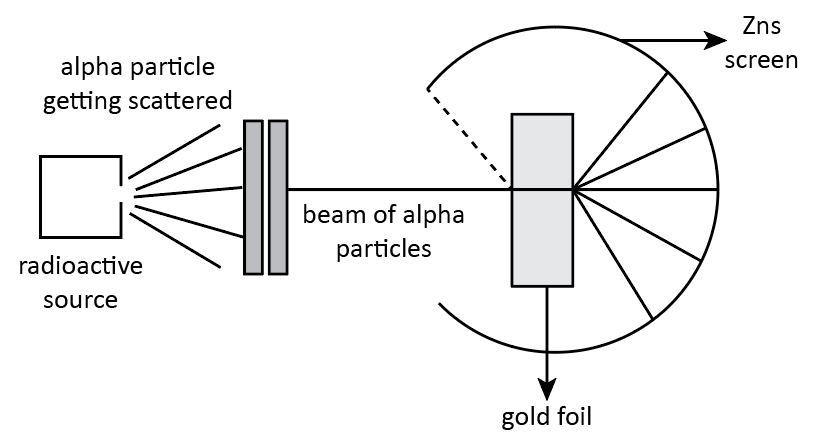
Who proposed the planetary model of the atom?
A. John Dalton (early
B. Ernest Rutherford
C. Niels Bohr
D. Joseph John Thomas
Answer
503.1k+ views
Hint: We know that, according to the planetary model of an atom, nucleus is positively charged due to the presence of protons in it and the negatively charged electrons revolve around it in a fixed circular orbit like planets spin around the sun. Therefore, this model is called the planetary model of the atom.
Complete step by step answer:
We know that, In
An atom is composed of three component particles which are electrons, protons and neutrons. The protons and neutrons are situated in the nucleus of an atom. However, the electrons are distributed uniformly outside the nucleus. There is no overall charge on an atom. This theory was proposed by Ernest Rutherford. Let’s discuss it in detail.
According to Rutherford, an atom is composed of a nucleus which is positively charged and the negatively charged electrons revolve around it in a fixed circular orbit. This conclusion was put forward on the basis of his scattering experiment.
The experiment performed by Rutherford gave three most important observations about an atom. The first observations of the alpha particle scattering experiment explains that most of the alpha particles passed straight from the foil without any failure in their direction. This observation confirms that there must be sufficient free space within the atom.
The second observation states that most of the alpha particles undergo deflection. Some particles experience small deflection whereas some particles experience large deflection. This observation confirms that there must be a positively charged body in an atom due to which the positively charged alpha particles experience repulsive force which lead to the small and large deflection. This confirms the presence of a heavy positively charged nucleus in the center of the atom.

Hence, we can say that Ernest Rutherford proposed the planetary model of the atom.
Therefore, the correct option is option (B).
Note:
As we know that, the mass and properties of all the atoms present in an element are identical. After the discovery of atoms, the different subatomic particles were also discovered by various experiments done by scientists. In the year,
Complete step by step answer:
We know that, In
An atom is composed of three component particles which are electrons, protons and neutrons. The protons and neutrons are situated in the nucleus of an atom. However, the electrons are distributed uniformly outside the nucleus. There is no overall charge on an atom. This theory was proposed by Ernest Rutherford. Let’s discuss it in detail.
According to Rutherford, an atom is composed of a nucleus which is positively charged and the negatively charged electrons revolve around it in a fixed circular orbit. This conclusion was put forward on the basis of his scattering experiment.
The experiment performed by Rutherford gave three most important observations about an atom. The first observations of the alpha particle scattering experiment explains that most of the alpha particles passed straight from the foil without any failure in their direction. This observation confirms that there must be sufficient free space within the atom.
The second observation states that most of the alpha particles undergo deflection. Some particles experience small deflection whereas some particles experience large deflection. This observation confirms that there must be a positively charged body in an atom due to which the positively charged alpha particles experience repulsive force which lead to the small and large deflection. This confirms the presence of a heavy positively charged nucleus in the center of the atom.

Hence, we can say that Ernest Rutherford proposed the planetary model of the atom.
Therefore, the correct option is option (B).
Note:
As we know that, the mass and properties of all the atoms present in an element are identical. After the discovery of atoms, the different subatomic particles were also discovered by various experiments done by scientists. In the year,
Recently Updated Pages
Master Class 11 Business Studies: Engaging Questions & Answers for Success

Master Class 11 Economics: Engaging Questions & Answers for Success

Master Class 11 Accountancy: Engaging Questions & Answers for Success

Master Class 11 Computer Science: Engaging Questions & Answers for Success

Master Class 11 English: Engaging Questions & Answers for Success

Master Class 11 Maths: Engaging Questions & Answers for Success

Trending doubts
Which one is a true fish A Jellyfish B Starfish C Dogfish class 11 biology CBSE

Difference Between Prokaryotic Cells and Eukaryotic Cells

1 ton equals to A 100 kg B 1000 kg C 10 kg D 10000 class 11 physics CBSE

One Metric ton is equal to kg A 10000 B 1000 C 100 class 11 physics CBSE

How much is 23 kg in pounds class 11 chemistry CBSE

Net gain of ATP in glycolysis a 6 b 2 c 4 d 8 class 11 biology CBSE




